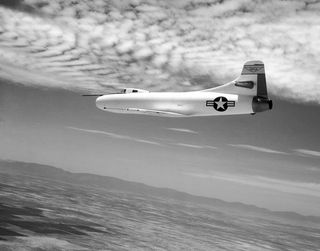Space History Photo: D-558-1 in Flight

In this historical photo from the U.S. space agency, even with partial cloud cover the white aircraft is easy to see. This is a 1952 NACA High-Speed Flight Research Station inflight photograph of the Douglas D-558-1 #3 Skystreak.
Conceived in 1945, the D558-1 Skystreak was designed by the Douglas Aircraft Company for the U.S. Navy Bureau of Aeronautics, in conjunction with the National Advisory Committee for Aeronautics (NACA). The Skystreaks were turojet powered aircraft that took off from the ground under their own power and had straight wings and tails.
Much of the research performed by the D-558-1 Skystreaks was quickly overshadowed in the popular media by Chuck Yeager and the X-1 rocketplane. But the Skystreak performed an important role in aeronautical research by flying for extended periods of time at transonic speeds, which freed the X-1 to fly for limited periods at supersonic speeds.
The National Advisory Committee on Aeronautics (NACA) was a precursor to NASA. NACA was created by Congress in 1915.
Each weekday, SPACE.com looks back at the history of spaceflight through photos (archive).
Get the Space.com Newsletter
Breaking space news, the latest updates on rocket launches, skywatching events and more!
Join our Space Forums to keep talking space on the latest missions, night sky and more! And if you have a news tip, correction or comment, let us know at: community@space.com.

The National Aeronautics and Space Administration (NASA) is the U.S. government agency in charge of the civilian space program as well as aeronautics and aerospace research. Founded in 1958, NASA is a civilian space agency aimed at exploring the universe with space telescopes, satellites, robotic spacecraft, astronauts and more. The space agency has 10 major centers based across the U.S. and launches robotic and crewed missions from the Kennedy Space Center in Cape Canaveral Florida. It's astronaut corps is based at the Johnson Space Center in Houston. To follow NASA's latest mission, follow the space agency on Twitter or any other social channel, of visit: nasa.gov.
